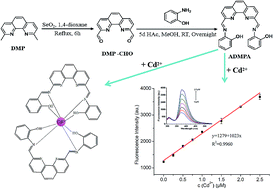A novel and fast responsive turn-on fluorescent probe for the highly selective detection of Cd2+ based on photo-induced electron transfer†
Abstract
A novel, highly sensitive and fast responsive turn-on fluorescence probe, 2,2′-((1E,1′E)-((1,10-phenanthroline-2,9-diyl)bis(methanylylidene)) bis(azanylylidene)) diphenol (ADMPA), for Cd2+ was successfully developed based on 2,9-dimethyl-1,10-phenanthroline and o-aminophenol. ADMPA showed a remarkable fluorescence enhancement toward Cd2+ against other competing cations, owing to the suppression of the photo-induced electron transfer (PET) and CH![[double bond, length as m-dash]](https://www.rsc.org/images/entities/char_e001.gif) N isomerization. A good linear relationship (R2 = 0.9960) was obtained between the emission intensity of ADMPA and the concentration of Cd2+ (0.25–2.5 μM) with a detection limit of 29.3 nM, which was much lower than that reported in literature. The binding stoichiometry between ADMPA and Cd2+ was 2 : 1 as confirmed by the Job's Plot method, which was further confirmed by a 1H NMR titration experiment. Moreover, the ADMPA probe was successfully applied to detect Cd2+ in real water samples with a quick response time of only 6.6 s, which was about 3–40 times faster than the reported cadmium ion probe.
N isomerization. A good linear relationship (R2 = 0.9960) was obtained between the emission intensity of ADMPA and the concentration of Cd2+ (0.25–2.5 μM) with a detection limit of 29.3 nM, which was much lower than that reported in literature. The binding stoichiometry between ADMPA and Cd2+ was 2 : 1 as confirmed by the Job's Plot method, which was further confirmed by a 1H NMR titration experiment. Moreover, the ADMPA probe was successfully applied to detect Cd2+ in real water samples with a quick response time of only 6.6 s, which was about 3–40 times faster than the reported cadmium ion probe.



 Please wait while we load your content...
Please wait while we load your content...